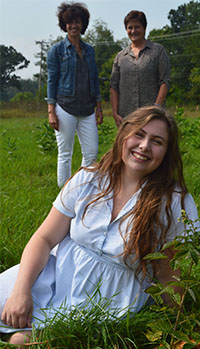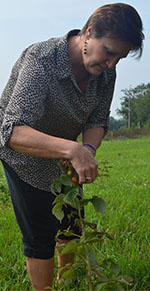Lynn Cvengros is always looking for writing and research opportunities for her students. When the Forest Hills Eastern High School Advanced Placement Language teacher came across an article about the “edible schoolyard” concept, she saw abundant potential.
In the article, renowned restaurateur, activist and author Alice Waters recounted her experience working with an urban California school district to create a garden on vacant land that is used to teach all subjects. Not only that, it serves as a gathering place for community functions, inspires students to learn where their food comes from, and even how to prepare it for themselves and others.
Waters, owner of the famed Chez Panisse restaurant in Berkeley, Calif., founded the Edible Schoolyard Project more than 20 years ago. It currently boasts a network of nearly 5,000 schools, businesses and other organizations around the world, and includes a teacher training academy and a “lab school” in Berkeley. Locally, five Grand Rapids Public Schools participate in the project.
Design, Think, Plan, Do
In another wing of the high school, some former students of science teacher Dolores Keeley told her about Cvengros’ edible schoolyard idea. Those students had participated in several projects in Keeley’s class that related to gardening on school property: soil testing, studying and planting native plants, constructing bluebird boxes and adding vegetation to the school’s detention pond to better absorb water runoff.
Keeley was excited to talk with Cvengros. She has been involved in Groundswell, a local initiative aimed at getting teachers, students and businesses involved in environmental stewardship.
“We got together and discovered we had this shared interest, not only in the garden but of its potential beyond students,” Keeley said. “We got really excited about that.”

That’s when Cvengros brought up design thinking.
“One thing you hear a lot is ‘not everyone is going to be a designer, but everyone can learn to design think,’ ” she said. “It’s about creating a mindset for people to innovate. We see design thinking as the process for students to develop our edible schoolyard.”
Thanks to a grant from Forest Hills’ “Destination: Innovation” campaign, the pair traveled to California last November to tour the first edible schoolyard, sit in on design thinking classes at Stanford and visit Nueva school, a k-12 private school in the Bay area that is structured around design thinking.
Cvengros developed a design-think project in the spring to begin research for the edible schoolyard. More than 70 juniors researched and wrote reports on soil types; landscape architecture; irrigation; and how to maintain the garden when school is not in session, to name just a few aspects.
In order to complete their research, they interviewed local experts such as landscape architects and organic farmers, state lawmakers and community leaders. Finally, to an audience of school staffers, teachers and their students, “they pitched what they would need to do and how they would do it,” Cvengros said.
‘I’m Excited to See This Grow’
Pearl Chapman was one of those students.
“It was nice to communicate with other students in a new way,” the senior said. “It was very idea-based, and it’s not that often you get experience like that in your courses. I appreciated having something solid we could produce with the skills we’ve been learning in our class.
“It’s been really fulfilling and really motivating,” she added. “I’m excited to see this grow throughout the school.”
Keeley also got a grant from the Forest Hills Education Foundation to plant 100 blueberry and 100 raspberry patches as a “seed” project of the edible schoolyard. Ninth-grade honors biology students used the design thinking process to determine where to plant, how to fertilize and what to anticipate in the harvesting.

The two teachers also attended a design-thinking summit this summer at Grand Valley State University to flesh out more of their vision. The hope is to wrap up planning and break ground next spring, then to evolve over time however design thinking leads the project.
“I have visions of us having a greenhouse, doing seed germination studies, middle-schoolers learning to cook and families coming to share dinners of food grown and prepared by students,” Keeley said. “What I saw in Berkeley was truly inspirational.”
Added Cvengros: “Other teachers are also starting to become interested. Our art teacher wants to coordinate with students to help design the gardens, and the industrial arts teacher wants to take the lead in designing and building beds. … The sky’s the limit with this.”
CONNECT
GVSU’s design thinking initiative
Forest Hills Public Schools Destination: Innovation Campaign









